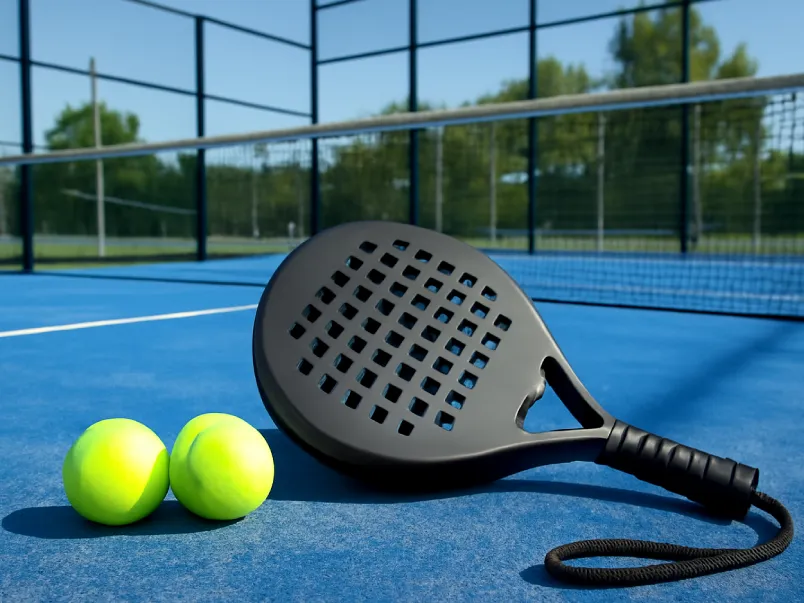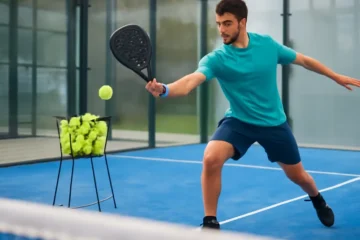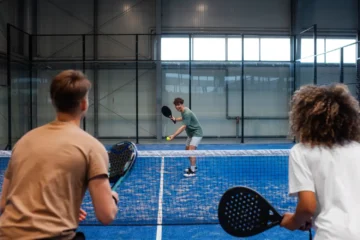Padel is one of the fastest-growing sports globally, and for good reason. Combining the excitement of tennis with the strategic elements of squash, it’s a fun, social, and addictive game that’s easier to pick up than tennis. Whether you’re new to sports or a seasoned athlete, padel is a fantastic game that anyone can enjoy.
If you’ve ever wondered about padel but didn’t know where to start, this guide is here to help. From the equipment you’ll need to the essential rules and strategies for playing, this article will provide everything you need to step onto the padel court with confidence. Let’s dive into the essentials!
What is Padel?
Padel is a racket sport that shares similarities with tennis and squash, typically played in doubles on an enclosed court. The key difference from tennis is the use of walls, which come into play after the ball bounces. The sport is fast-paced yet highly strategic, making it perfect for players of all skill levels. Its social nature and relatively simple learning curve contribute to its growing popularity worldwide.
Thesis
This guide will break down the essential rules, scoring, and etiquette of padel, so you can quickly learn how to play and start enjoying the sport. From understanding the court and equipment to learning the basic rules and strategies, we’ve got you covered!
1. The Basics: Court & Equipment
1.1. The Padel Court
The padel court is smaller than a tennis court and enclosed on all sides, measuring 20 meters in length and 10 meters in width. This design incorporates walls made of glass or wire mesh, which play a vital role in the game. The ball can bounce off these walls, adding an extra layer of strategy and excitement to the sport.
Key features of a padel court include:
- Glass/Wire Mesh Walls: The side and back walls are made of glass or wire mesh, allowing the ball to bounce off them during play.
- Metal Fence: The perimeter is surrounded by a metal fence, marking the boundaries of the court.
- The Net: A central net divides the court into two halves, similar to a tennis court.
The lines on the court include:
- Base Lines: The lines at the back of the court, marking the furthest boundary for play.
- Service Boxes: The area where the ball must land during a serve.
- Central Service Line: This line divides the two service boxes on each side of the net.
1.2. The Padel Racket
Unlike a tennis racket, the padel racket is solid with no strings, featuring a perforated surface that provides a different feel when hitting the ball. It’s smaller and lighter, typically weighing between 330 and 375 grams.
The racket also features a safety cord, which is mandatory. This cord should be wrapped around your wrist during play to prevent accidental drops.
1.3. The Ball
Padel balls are similar to tennis balls, but with slightly less pressure. They are a bit softer, which helps with the ball’s bounce off the walls. While tennis balls can be used for casual games, official padel balls are recommended for more serious play, as they offer better durability and performance.
2. The Objective & Scoring System (The Easy Part!)
2.1. How to Win a Point
In padel, a point can be won in several ways:
- Two Bounces: The ball bounces twice on your opponent’s side.
- Direct Hit: The ball hits an opponent directly before bouncing.
- Out of Bounds: The ball goes out of the court, either by going over the walls or hitting the fence before bouncing on the opponent’s side.
2.2. The Scoring System
The scoring system in padel is the same as tennis:
- Love: 0 points
- 15: 1 point
- 30: 2 points
- 40: 3 points
- Game: 4 points
If both players or teams reach 40 points, the score is called “Deuce”. From there, one player or team must win two consecutive points to win the game. The first point after deuce is called “Advantage.”
2.3. Winning a Game, Set, and Match
- Game: A game is won when a player or team reaches four points, provided they lead by at least two points.
- Set: A set is won when a player or team wins six games, but they must lead by at least two games. If the score reaches 5-5, the set continues until one side leads by two games.
- Match: Most matches are played as a best-of-three sets, though some formats may vary.
3. Core Gameplay Rules
3.1. The Serve
The serve in padel is similar to tennis but has a few key differences:
- Underhand Serve: The ball must be served underhand, and the server must strike the ball below waist level.
- Bounce: The ball must first bounce on the server’s side before crossing the net and landing in the opponent’s service box.
- One Attempt: Unlike tennis, the server only gets one serve attempt.
- Serving Box: The server must stand behind the baseline and between the central service line and the side wall.
3.2. The “Golden Rule”: Using the Walls
One of the most exciting aspects of padel is the use of walls:
- Legal Wall Bounces: After the ball bounces on your side of the court, you can use the walls to help return it.
- Wall Play: You can hit the ball off the back or side walls, creating dynamic rally situations.
- The Return: You can either volley the ball (hit it before it bounces) or let it hit the wall and then return it.
3.3. What is “Out”?
In padel, the ball is considered “out” if:
- It goes out of the court, either by crossing over the walls or hitting the fence before bouncing on the opponent’s side.
- If the ball hits the fence or wall directly on your opponent’s side, it is also considered out.
4. Key Rule Exceptions & Common Scenarios
4.1. The Double Bounce Rule
A fundamental rule in padel is the double bounce rule: the ball cannot bounce twice on your side. If you fail to return the ball before the second bounce, you lose the point.
4.2. The Net Rule
- Serve Let: If the ball hits the net on a serve but lands in the correct service box, it’s considered a “let” and the serve is replayed.
- Rally Let: If the ball hits the net during a rally and goes over, the play continues as usual.
4.3. Interference
- Partner Interference: If the ball hits your partner or your racket flies out of your hand during a rally, the point is typically lost.
- Player Movement: Always ensure you’re aware of your surroundings and not obstructing your partner or opponents during play.
5. Beginner Strategy & Etiquette
5.1. Basic Positioning
Net Positioning: One of the key principles in padel is controlling the net. Try to get to the net with your partner as soon as possible. This dominant position allows you to take charge of the rally and apply pressure on your opponents.
Formation: At the net, position yourself side-by-side with your partner, but maintain flexibility for quick adjustments. When serving or returning, stay near the baseline but ready to advance toward the net.
5.2. Simple Shots to Master
Here are some of the essential shots every beginner should work on:
- The Bandeja: A defensive overhead shot used to return a lob. It’s controlled and helps you reposition yourself.
- The Vibora: A more aggressive overhead shot with spin, designed to put pressure on your opponents.
- The Bajada: A shot played off the back glass, typically used when the ball comes in high from your opponent’s side.
5.3. Padel Etiquette (Unwritten Rules)
Good etiquette is essential for maintaining a fun and fair environment:
- Calling Balls: Be clear and honest when calling balls “in” or “out.”
- Safety First: Always be mindful of your partner’s position and avoid swinging your racket too wildly.
- Respect for Opponents: Be courteous and respectful toward your opponents, whether you win or lose.
Conclusion
Padel is an accessible, fun, and social game that’s perfect for players of all levels. The sport is growing quickly worldwide, thanks to its simple scoring system, unique rules involving wall play, and friendly atmosphere.
Now that you understand the fundamentals, the best way to learn is by playing! Grab a racket, find a local court, and dive into the world of padel. Before you know it, you’ll be mastering those bandejas and viboras, having fun, and building lasting friendships on the court. Enjoy the game!
FAQs
1. What is the main objective of padel?
The main objective of padel is to win points by either having the ball bounce twice on your opponent’s side, hitting your opponent directly, or forcing them to hit the ball out of bounds. Players use the walls as part of the game strategy, creating a unique playing experience compared to tennis.
2. Can I use a tennis racket for padel?
Technically, you can use a tennis racket for casual games, but it’s recommended to use a padel racket for official play. Padel rackets are smaller, perforated, and designed to handle the specific demands of the sport.
3. How do you serve in padel?
The serve in padel is underhand and must be hit below the waist level. The ball must bounce on your side before crossing the net and landing in the opponent’s service box. You only get one serve attempt, unlike tennis where players get two.
4. How does the scoring system work in padel?
The scoring system in padel is identical to tennis, with points awarded as Love (0), 15, 30, 40, and Game. If the score reaches deuce (40-40), a player must win two consecutive points to win the game. A match is typically played as a best-of-three sets.
5. What are the walls used for in padel?
The walls in padel play a crucial role. After the ball bounces on your side of the court, you can use the walls to bounce the ball back to your opponent’s side. This unique feature creates exciting rallies and strategic opportunities.
6. Do I need to follow any special etiquette when playing padel?
Yes! Padel etiquette includes being honest when calling balls “in” or “out,” being mindful of your partner’s movements, and always showing respect for your opponents. Safety is also a priority, so always be aware of your surroundings when swinging your racket.
7. Is padel difficult to learn?
No, padel is easier to pick up than tennis due to its simple rules and smaller court size. It’s an excellent game for beginners and also enjoyable for seasoned players looking for a fun, social sport.




